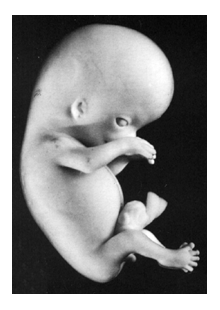The Stages of Human Embryonic Development
Stage 23 embryos have a greatest length of 23 to 32.2 mm and an estimated postfertilization age of 53 to 58 days. Over 90% of the more than 4,500 named structures in the adult body are present. All named muscles can be identified. The limbs are quite elongated and the hands and feet can overlap each other. The external genitalia are prominent but not yet sexually distinct. The insula and subdivisions of the lateral ventricle can be identified in the cerebral vesicle (hemisphere), the superior and inferior colliculi are evident in the tectum of the mesencephalon and the external granular layer of the cerebellum has formed in the alar plate of the metencephalon. Many nuclei, fiber tracts, decussations and commissures are evident in the brainstem and all four parasympathetic ganglia in the head are present. The upper and lower eyelids are beginning to fuse with each other both laterally and medially. The spiral cochlear duct attains its definitive arrangement of 2 ½ turns. The laryngeal cartilages are present, the palatine shelves are fusing with each other and the nasal septum, and the salivary gland ducts have begun secondary branching. Ossification has begun in the skull and the long bones. Most of the named arteries to the brain can be identified and the left superior vena cava is no longer present. The kidney exhibits 4 to 5 orders of tubules, and tubules can be identified in the testis but are not yet fused with the rete testis and mesonephric duct.
| Browse the section images |
| 3D reconstructions |
| More info ... |
